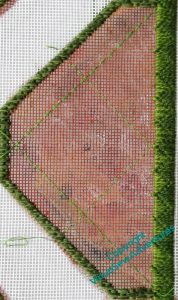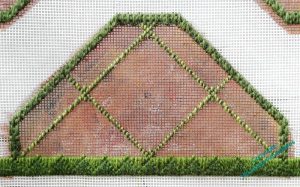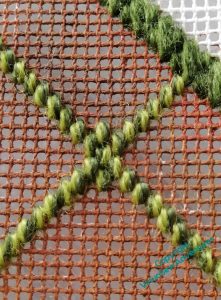Planning the long borders
The long borders just looked too big, too monolithic, if you like, when I came to look at them with the corners in place. I don’t want the pattern looking too “bitty” and fragmented, but a certain amount of breaking up of the shape seemed to be a good idea.
I started by running tacking stitches in stranded cotton so that I could look at the divisions they created and make decisions based on those, rather than using the wool. Tapestry canvas is a destroyer of thread, and it’s rare that you can reuse much of it if you have to take it out. I’ve plenty of stranded cotton, and I can reuse it a few times for experiments – just not for the final piece!
That seemed enough of a division, so I pulled out the stranded cotton and reinstated the new lines using short straight stitches in two shades of the Paterna.
I’m trying to use all the yarn in blends. It makes for a livelier effect, and given I’m not enamoured of Yarn Chicken, it will also eke out some of the yarns!
Once I’d looked at the first couple of intersections between lines, I decided to add a bit of subtle emphasis. At this point, I had no idea what stitches I would be using in the “beds” (to retain the link to gardening), but I somehow felt that I needed to blunt the apex of the diamond and triangle shapes.
I couldn’t tell you why – any ideas?




Well, they look better blunted. The intersection of that sort of diagonal does often feel “weak” compared to the lines themselves: one central stitch taking the weight of two intersecting lines. It also adds a little individually.
Maybe it softens the shape a bit but it looks great.
It stops the eye from following down from the ‘arrow point’ of the intersection. Without the blunting your look would just be pulled down out of the beds.
You worked that by instinct, didn’t you? Often the best choices we make are those we have no idea why we settled for. Depending on what stitches you use for the ‘beds’, these blunted stitches may emphasise or weaken the intersections. Choose well !
Won’t it depend on the stitches you are using in the beds?
Probably because it echoes the flattened shape of the top of the bed. In any case, it’s a nice illustration of following your instinct when you design. The gut feeling is usually the right one!